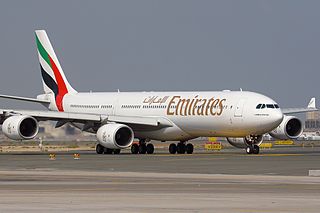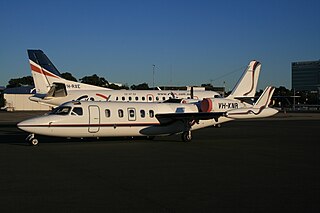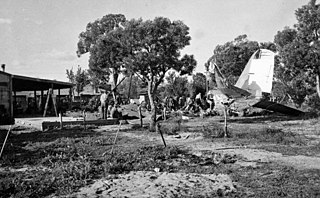
Moorabbin Airport is a mostly general aviation airport for light aircraft located in between the southern Melbourne suburbs of Heatherton, Cheltenham, Dingley Village and Mentone. It also receives commercial airline service. The airport grounds are treated as their own suburb, and share the postcode 3194 with the neighbouring suburb of Mentone. With a total of 274,082 aircraft movements, Moorabbin Airport was the second busiest airport in Australia for the calendar year 2011.

One-Two-Go Airlines Co. Ltd was a low-cost airline based in Don Mueang, Bangkok, Thailand. Its main base was Don Mueang International Airport, Bangkok. It was owned and managed by Orient Thai Airlines and CEO Udom Tantiprasongchai and his wife Nina Tantiprasongchai. The One-Two-Go brand was retired in July 2010, after the crash of flight OG 269 in September 2007 was blamed substantially on misconduct by the airline, with the aircraft re-branded under Orient Thai Airlines. On 9 October 2018, Orient Thai Airlines ceased all operations.

The Piper PA-31 Navajo is a family of twin-engined utility aircraft designed and built by Piper Aircraft for small cargo and feeder airlines, and as a corporate aircraft. Production ran from 1967 to 1984. It was license-built in a number of Latin American countries.

Mohawk Airlines Flight 40 was a scheduled passenger flight between Syracuse, New York and Washington, DC, with an intermediate stop in Elmira, New York. On June 23, 1967 it suffered a loss of control and crashed, killing all 30 passengers and four crew on board. It was the deadliest disaster in the airline's history. A valve in the auxiliary power unit had suffered a complete failure, spreading fire to the tailplane, causing a loss of pitch control.
Transair was an airline based in Australia. The Civil Aviation Safety Authority cancelled the Air Operator's Certificate, at the request of Transair, on 4 December 2006. Transair ceased all operations from that date. This action followed investigations by the Civil Aviation Safety Authority and Australian Transport Safety Bureau into the airline's safety after the fatal accident of one of Transair's aircraft on 7 May 2005.

A hard landing occurs when an aircraft or spacecraft hits the ground with a greater vertical speed and force than in a normal landing. The terms hard landing and firm landing are often mixed up though are inherently different. A hard landing is never intended and if an aircraft has had a hard landing, it must be inspected for damage before its next flight. In contrast, depending on aircraft type and/or environmental conditions a firm landing is intended and even demanded by the aircraft manual.
Whyalla Airport is an airport located 4 nautical miles southwest of Whyalla, South Australia.

Garuda Indonesia Flight 200(GA200/GIA 200) was a scheduled domestic passenger flight of a Boeing 737-400 operated by Garuda Indonesia between Jakarta and Yogyakarta, Indonesia. The aircraft overran the runway, crashed into a rice field and burst into flames while landing at Adisucipto International Airport on 7 March 2007. Twenty passengers and one flight attendant were killed. Both pilots survived, and were fired shortly after the accident occurred. It was the fifth hull-loss of a Boeing 737 in Indonesia within less than six months and was the most recent accident with fatalities involving the airline.

Advance Airlines Flight 4210 was a scheduled passenger flight which crashed at Sydney Airport on 21 February 1980, killing all 13 people on board the Advance Airlines Beech Beechcraft King Air 200. After taking off on runway 25 for a scheduled flight the aircraft's left (port) engine failed and the pilot requested an emergency landing on runway 34. The plane crashed into the sea wall while attempting the emergency landing. The accident caused the greatest number of fatalities in a civil aircraft crash in Australia since MacRobertson Miller Airlines Flight 1750, a Vickers Viscount that crashed near Port Hedland in Western Australia on 31 December 1968 killing all 26 on board.

On 4 September 2000, a chartered Beechcraft 200 Super King Air departed Perth for a flight to the mining town of Leonora, Western Australia. The aircraft crashed near Burketown, Queensland, Australia, resulting in the deaths of all eight occupants. During the flight, the aircraft climbed above its assigned altitude. When air traffic control (ATC) contacted the pilot, the pilot's speech had become significantly impaired, and he was unable to respond to instructions. Three aircraft intercepted the Beechcraft, but were unable to make radio contact. The aircraft continued flying on a straight north-easterly heading for five hours, before exhausting its fuel and crashing 40 mi (65 km) south-east of Burketown. The crash became known in the media as the "ghost flight".

The Lockhart River air disaster occurred on 7 May 2005, when Aero-Tropics Air Services Flight 675 crashed while on approach to land at Lockhart River Airport in Queensland, Australia, on a ridge known as South Pap 6 nautical miles (11 km) north-west of the airport. All fifteen on board died as the aircraft was completely destroyed by impact forces and subsequent fire. The Fairchild Swearingen Metroliner commuter aircraft, registered VH-TFU, was owned by Transair Ltd and operated by Aero-Tropics. The flight was scheduled from Bamaga on Cape York to the regional centre of Cairns, with a stopover in Lockhart River. It was the worst air crash in Australia in 36 years since MacRobertson Miller Airlines Flight 1750 on 31 December 1968.

Emirates Flight 407 was a scheduled international passenger flight operated by Emirates from Auckland to Dubai with a stopover in Melbourne, operated by an Airbus A340-500 aircraft. On 20 March 2009, the flight failed to take off properly at Melbourne Airport, hitting several structures at the end of the runway before climbing and then returning to the airport for a safe landing. Although no fatalities or injuries resulted, damage to the aircraft was severe enough for the event to be classified by Australian Transport Safety Bureau as an "accident". It was subsequently determined that a data-entry error resulted in insufficient engine thrust during take off. It has been described "as close as we have ever come to a major aviation catastrophe in Australia" by aviation officials.

The 2009 Pel-Air Westwind ditching or Norfolk Island ditching was an aircraft accident on 18 November 2009 near Norfolk Island, Australia. A Westwind II jet operated by Pel-Air was conducting an air ambulance flight for CareFlight International when it was forced to ditch after being unable to land in bad weather and not having sufficient fuel to divert to an alternate destination.

Qantas Flight 32 was a regularly scheduled passenger flight from London to Sydney via Singapore. On 4 November 2010, the aircraft operating the route, an Airbus A380, suffered an uncontained failure in one of its four Rolls-Royce Trent 900 engines. The failure occurred over the Riau Islands, Indonesia, four minutes after takeoff from Singapore Changi Airport. After holding for almost two hours to assess the situation, the aircraft made a successful emergency landing at Changi. No injuries occurred to the passengers, crew, or people on the ground, despite debris from the aircraft falling onto houses in Batam.

On 2 July 1949 a Douglas DC-3 aircraft departed from Perth, Western Australia for a night flight of 441 nautical miles (817 km) to Carnarvon. The aircraft climbed to a height of about 500 feet (150 m) and then spiralled almost vertically to the ground, killing all 18 people on board. It crashed about a mile north of Perth airport and burned for over an hour. At the time, it was the worst civil aviation accident in Western Australia.

On 10 March 1949 a Lockheed Lodestar aircraft became airborne at Coolangatta, Queensland, Australia for a flight to Brisbane. Before reaching a height of 300 feet (90 m) it suddenly pitched nose-up, stalled and crashed onto its belly beyond the end of the airstrip.

Dana Air Flight 0992 was a scheduled Nigerian domestic passenger flight from Abuja to Lagos, Nigeria. On 3 June 2012, the McDonnell Douglas MD-83 aircraft serving the route suffered a dual-engine failure during its approach to Lagos. It failed to reach its intended destination and crashed onto buildings, killing all 153 people on board and six on the ground. With 159 deaths, it remains as the deadliest commercial airliner crash in Nigerian history since the Kano air disaster in 1973.

On 1 October 2012, Riama, a 1934 vintage de Havilland DH.84 Dragon passenger aircraft, crashed in Queensland, Australia, while flying from Monto to Caboolture. Radio contact was lost about an hour after the pilot reported to be in cloud with zero visibility. The wreckage was found in heavily wooded, hilly terrain two days later. The pilot and five passengers were killed in the accident.

On 21 February 2017, at 8:59 am local time, a Beechcraft B200 King Air aircraft operating a charter flight, carrying a pilot and four passengers bound for King Island, crashed seconds after taking off from Essendon Airport in Melbourne, Australia.

The 1994 South Pacific Airmotive DC-3 crash took place on 24 April 1994, when a Douglas DC-3 airliner operated by South Pacific Airmotive, tail number VH-EDC, ditched into Botany Bay shortly after takeoff from Sydney Airport in Sydney, New South Wales, Australia. The cause of the crash was determined by the Bureau of Air Safety Investigation to have been a power loss in the aircraft's left engine caused by an inlet valve being stuck in the open position, compounded by inadequate action on the part of the pilots; Rod Lovell, the pilot in command of the flight, has disputed BASI's conclusions.




















